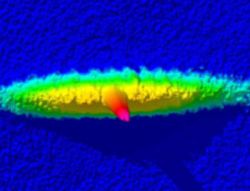
[2013-12-13] Today Physics World, the journal of the British Institute of Physics (IOP), has published a list of the ten most important success stories in physics in 2013. One of the accomplishments on the list is the creation of the world’s first Bose-Einstein condensate cooled using just laser cooling, realized by experimental physicist Florian Schreck and his colleagues at the IQOQI in Innsbruck, Austria.
When the first Bose-Einstein condensates (BEC) were realized in the mid nineties, the exceptional properties of these quantum gases opened up a new avenue to study the quantum world. To create a Bose-Einstein condensate, atoms are contained in a magnetic trap and cooled to close to absolute zero −273,15 °C. This method, however, has its limits as the processes triggered by the lasers heat the quantum gas. The experimental physicists have to add an additional stage to again cool the atoms to force all the particles into a single quantum state. During this so called evaporative cooling stage, the higher-energy particles are allowed to leave the trap and the atomic cloud is cooled until the required temperature to form a BEC is reached. However, during this process about 99 % of the atoms are lost. Florian Schreck and his colleagues from Rudolf Grimm’s research group at the Institute of Quantum Optics and Quantum Information of the Austrian Academy of Sciences in Innsbruck found a way to avoid this last stage. With their method the physicists are also able to constantly renew the BEC, which paves the way to develop a continuous atom laser.
Success with a little trick
“We used the element strontium for our experiment and combined several commonly used approaches,” says Florian Schreck, who, at the beginning of December, moved with his team to the University of Amsterdam where he accepted a professorship. “In the optical dipole trap where we contain the atoms, we created a small ‘dimple’ in which the trapping potential is higher,” explains the physicist. “The particles naturally have a higher density in this region. This would usually lead to an increase in the negative side effects of the cooling laser. With a second laser beam focused on the dimple in the potential the atoms become invisible for the cooling laser in this region. The densely packed particles in the dimple then thermalize with the laser cooled atom cloud. By achieving a high density and a low temperature at the same time, a Bose-Einstein condensate forms in the dimple.”
This new method is simpler, faster and considerably more efficient than the previous method that relies on evaporative cooling. “We hope that our new approach will lead to more widespread use of BECs in various areas of physics including atomic clocks and atom lasers,” says Florian Schreck with a view into the future. At the University of Amsterdam he hopes to build such a continuous atom laser. “An atom laser could, for example, be used for ultra-sensitive interferometry or developing an optical atomic clock,” says the physicist. “We are very pleased that our younger researchers have achieved these pioneering results and are sought after internationally,” says a happy IQOQI Director Rudolf Grimm.